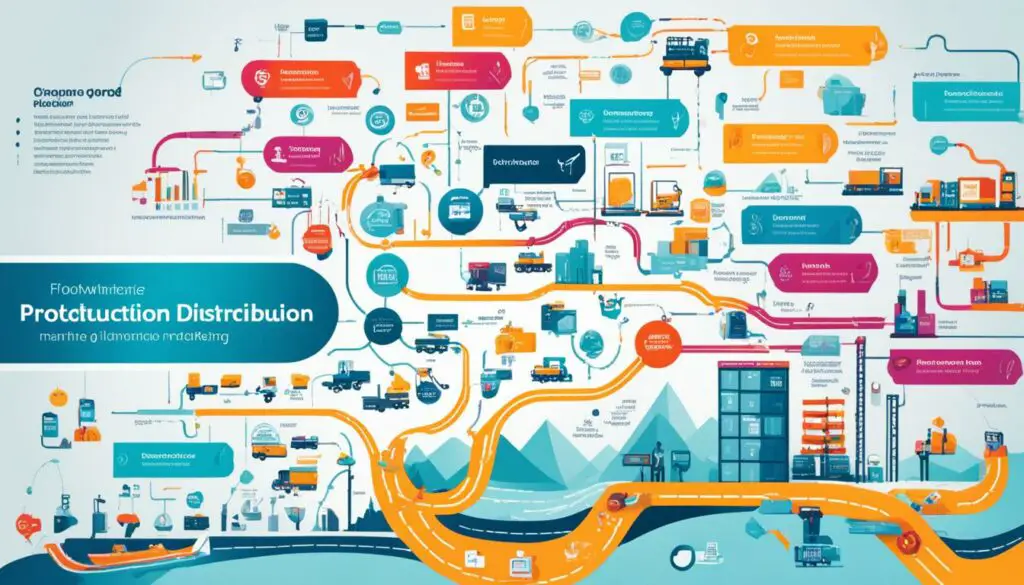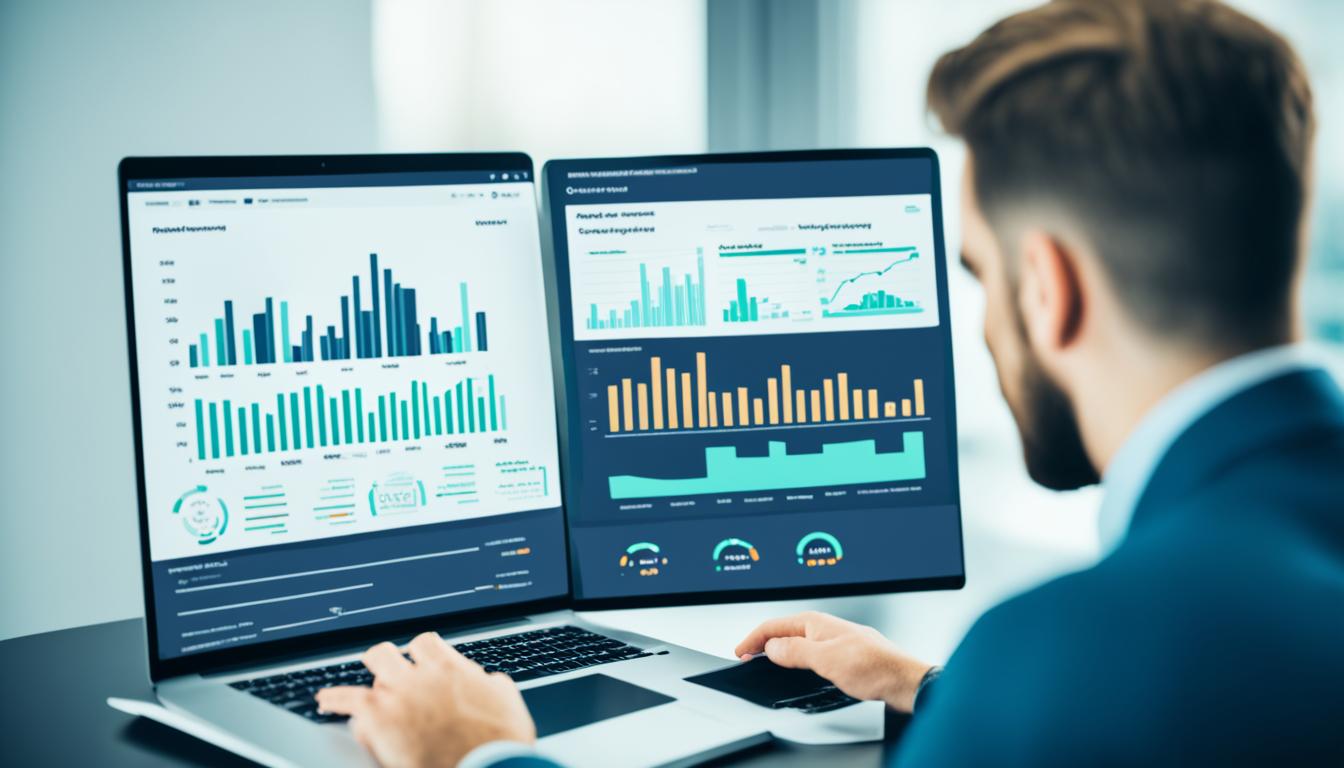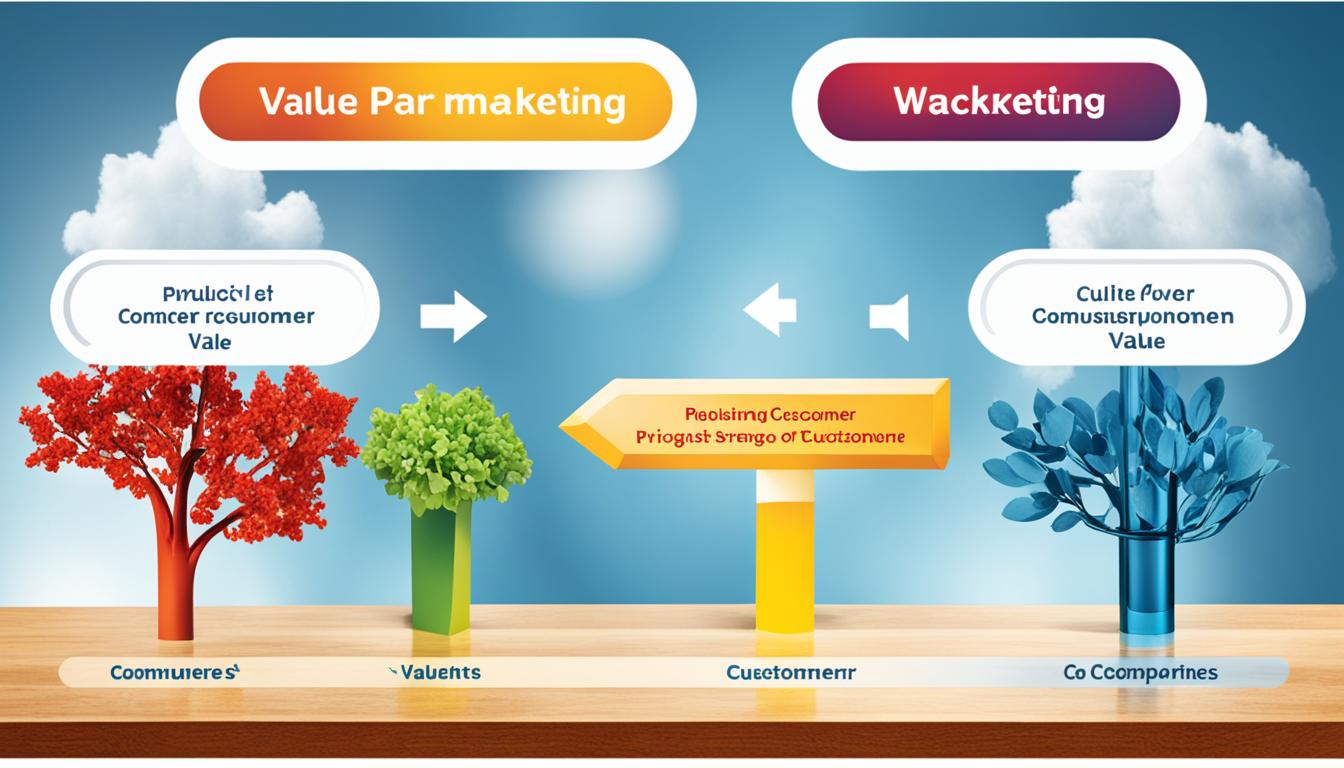When it comes to developing a successful marketing strategy, it’s crucial to consider all stages of the customer journey. This is where upstream marketing plays a significant role. Upstream marketing focuses on customer research, market analysis, and product development to anticipate and meet the evolving needs of your target audience. It is a long-term approach that sets the foundation for a robust marketing plan.
By understanding your customers’ pain points and challenges, upstream marketing allows you to develop innovative solutions that resonate with your audience. It involves identifying customer segments, conducting thorough market research, and gaining insights into your competitors.
With the information gathered, you can create products or services that directly address these needs, ensuring your brand is ahead of the curve. Upstream marketing also considers pricing strategies and competitive advantages to position your offering effectively in the market.
What sets upstream marketing apart is its forward-thinking nature. It not only addresses current customer demands but also provides a roadmap for future releases and developments. By strategically planning your product roll-outs, you can stay one step ahead of the competition and ensure sustained growth.
Key Takeaways:
- Upstream marketing is a long-term strategy that involves customer research, market analysis, and product development.
- It focuses on anticipating and meeting the evolving needs of your target audience.
- By understanding your customers’ pain points, you can develop innovative solutions that resonate with your audience.
- Upstream marketing helps in positioning your offering effectively in the market and planning future releases.
- By strategically planning your product roll-outs, you can stay ahead of the competition and ensure sustained growth.
What is Upstream Marketing?
Upstream marketing is a proactive approach that focuses on the early stages of the customer journey. It involves conducting market research, analyzing competitor data, and identifying gaps in the market. The goal of upstream marketing is to anticipate and fulfill unmet customer needs through innovative thinking.
This long-term plan allows companies to lay a solid foundation for future market engagement. By understanding customer segments and their unique challenges, businesses can develop effective solutions and strategies that resonate with their target audience.
Customer Segments and Challenges
One of the key aspects of upstream marketing is identifying customer segments and understanding their challenges. By segmenting the market, businesses can tailor their products or services to specific groups of customers, addressing their distinct pain points.
For example, an electronics company may identify two customer segments – tech enthusiasts and casual users. Tech enthusiasts may be looking for cutting-edge features and high-performance devices, while casual users may prioritize user-friendly interfaces and affordability.
By understanding these customer segments and the challenges they face, businesses can develop solutions that meet their specific needs, creating a competitive edge in the market.
Pricing and Competitive Edge
Another aspect of upstream marketing is determining pricing and establishing a competitive edge. Through market research and analysis, businesses can identify the optimal pricing strategy that aligns with their target customers’ perceived value and willingness to pay.
Additionally, upstream marketing allows businesses to differentiate themselves from their competitors by identifying unique selling propositions and developing a strong competitive edge. This can be achieved through product innovation, customer experience enhancements, or strategic partnerships.
Solutions and Market Opportunities
By focusing on upstream marketing, businesses can identify market gaps and develop solutions that address unmet customer needs. This proactive approach enables companies to stay ahead of the curve and capitalize on emerging market opportunities.
For example, a clothing brand may identify a growing trend towards sustainable fashion. By leveraging upstream marketing, the brand can develop eco-friendly products that cater to this market demand, positioning themselves as a leader in sustainability.
| Challenges | Solutions |
|---|---|
| Limited market awareness | Investing in targeted marketing campaigns |
| Undefined customer segments | Conducting in-depth market research and segmentation |
| Intense competition | Developing a unique value proposition and competitive edge |
| Uncertain pricing strategy | Analyzing market data and understanding customer perception of value |
The Importance of Upstream Marketing
Upstream marketing plays a vital role in driving the success of businesses by focusing on key aspects such as brand building, audience segmentation, and market research. By understanding customer needs and preferences, upstream marketing lays the foundation for effective future marketing strategies.
One of the primary objectives of upstream marketing is brand building. It involves creating a strong and recognizable brand identity that resonates with the target audience. By establishing a cohesive brand image, companies can enhance customer trust and loyalty, while differentiating themselves from competitors.
Audience segmentation is another crucial aspect of upstream marketing. By dividing the target market into distinct groups based on demographics, psychographics, and purchasing behaviors, businesses can tailor their marketing efforts to specific customer segments. This personalized approach allows companies to deliver targeted messages and offerings that are more likely to resonate with their audience.
Market research is an integral part of upstream marketing, providing insights into market trends, customer preferences, and competitor analysis. Through thorough market research, businesses can identify new opportunities, better understand their target audience, and make informed decisions about product development and marketing strategies.
With upstream marketing, companies also gain a competitive advantage in the future. By forecasting market trends and analyzing customer data, businesses can develop long-term strategies that align with the evolving needs and preferences of their target audience. This forward-thinking approach helps build a loyal customer base and positions the company for growth and success in the long run.
In conclusion, upstream marketing plays a critical role in brand building, audience segmentation, market research, and future marketing. By investing in upstream marketing strategies, businesses can develop a loyal customer base, identify new markets, and fuel their long-term growth and success.
What is Downstream Marketing?
Downstream marketing plays a crucial role in the sales process, targeting customers who are actively considering a purchase. Unlike upstream marketing, which focuses on long-term strategies, downstream marketing takes a more reactive approach, aiming to drive immediate sales through targeted campaigns.
At this stage, companies utilize various tactics such as direct advertising, sales promotions, personal selling, and retargeting ads. The goal is to convert prospects into current customers and maximize short-term sales opportunities.
Targeted Campaigns for Immediate Sales
Downstream marketing relies on targeted campaigns to reach specific customer segments and promote products or services that align with their needs. By tailoring marketing messages and offers to match the preferences of potential buyers, businesses can increase the likelihood of conversion and generate short-term sales momentum.
This targeted approach allows companies to optimize their advertising and promotional efforts, ensuring that they allocate resources efficiently and effectively reach their intended audience.
The Power of Advertising and Sales Promotions
Advertising is a key component of downstream marketing, enabling companies to communicate directly with consumers and create brand awareness. From television commercials to digital ads, advertising helps raise product or service visibility and stimulate immediate interest among potential buyers.
In addition to advertising, sales promotions are an effective way to incentivize customers to make a purchase. Promotions such as discounts, limited-time offers, or special deals can entice prospects to take action, resulting in increased short-term sales.
Capitalizing on Customer Consideration
Downstream marketing thrives on capturing customers’ attention during the consideration phase of their decision-making process. By strategically positioning products or services and leveraging persuasive messaging, businesses can foster a sense of urgency and capitalize on customers’ intention to buy.
Furthermore, personal selling or one-on-one interactions with potential customers can provide valuable insights about their needs and preferences. This direct engagement allows companies to address customer concerns, provide tailored recommendations, and increase the likelihood of conversion.
In summary, downstream marketing focuses on immediate sales through targeted campaigns, advertising, sales promotions, and personal selling. By capitalizing on customers’ consideration phase, businesses can convert prospects into paying customers and drive short-term revenue growth.
The Role of Downstream Marketing
Downstream marketing plays a crucial role in the overall marketing strategy by taking a tactical approach to convert prospects into paying customers. Unlike upstream marketing, which focuses on long-term planning, downstream marketing aims for immediate sales and revenue growth.
One of the key objectives of downstream marketing is to address specific pain points of potential customers. By understanding their needs and challenges, marketers can develop targeted campaigns that effectively communicate how their products or services can provide solutions.
Downstream marketing utilizes various strategies to reach and engage customers. These include:
- Advertising: By strategically placing advertisements in relevant channels, marketers can increase brand visibility and attract potential customers.
- Sales promotions: Offering discounts, limited-time offers, or exclusive deals can incentivize prospects to take immediate action and make a purchase.
- Personal selling: Through direct sales interactions, sales representatives can provide personalized information and guidance to prospects, nurturing them towards conversion.
- Retargeting ads: By displaying targeted advertisements to users who have previously engaged with the brand, marketers can reinforce their message and encourage them to revisit the website or make a purchase.
These tactics are designed to create a sense of urgency and drive prospects towards the final step of the customer journey – making a purchase. By employing downstream marketing strategies, businesses can effectively convert prospects into paying customers, resulting in immediate revenue growth.
Now, let’s take a look at the table below to see how downstream marketing compares to upstream marketing:

| Downstream Marketing | Upstream Marketing |
|---|---|
| Tactical approach | Long-term planning |
| Converts prospects into customers | Identifies customer segments |
| Addresses specific pain points | Develops products or services |
| Targeted campaigns | Conceptualizes future releases |
The Relationship Between Upstream and Downstream Marketing
Upstream and downstream marketing are two interconnected components that work collaboratively to create a smooth and efficient product development cycle. While upstream marketing focuses on the initial stages of product conceptualization, downstream marketing comes into play during the execution phase. By understanding the relationship between these two marketing approaches, businesses can develop customer-centric campaigns that drive success.
Upstream marketing plays a critical role in identifying customer segments, challenges, and benefits. It involves conducting thorough market research, gathering valuable customer insights, and analyzing market trends. This upstream analysis provides the foundation for developing customer-centric products designed to address specific pain points and meet customer needs.
On the other hand, downstream marketing is all about executing focused campaigns that effectively target specific audiences. It encompasses activities such as advertising, sales promotions, personalized marketing messages, and retargeting ads. This approach ensures that the right message is delivered to the right audience at the right time, maximizing the chances of conversion and driving immediate sales.
Together, upstream and downstream marketing create a comprehensive and customer-focused marketing strategy that covers the entire product development cycle. Upstream marketing sets the direction by identifying customer needs and developing products to fulfill those needs. Downstream marketing then takes over, meticulously executing campaigns to engage targeted audiences and convert prospects into customers.
In this way, the relationship between upstream and downstream marketing ensures that businesses stay customer-centric throughout the entire marketing process. It keeps teams aligned, promotes effective messaging, and optimizes marketing effectiveness. By adopting an integrated approach to marketing, companies can achieve sustained growth and forge meaningful connections with their target audience.
Benefits of the Upstream and Downstream Marketing Relationship
The harmonious collaboration between upstream and downstream marketing has several advantages:
- Efficient product development: By leveraging upstream marketing insights, businesses can develop products that precisely cater to customer needs, reducing the risk of launching unsuccessful offerings.
- Targeted campaigns: Downstream marketing allows companies to execute focused campaigns that align with specific customer segments, increasing engagement and conversion rates.
- Improved messaging: The relationship between upstream and downstream marketing ensures consistent, customer-centric messaging, enabling businesses to effectively communicate their unique value proposition.
- Enhanced customer experience: By understanding customer segments and pain points, companies can deliver tailored experiences that resonate with their audience, ultimately driving customer satisfaction and loyalty.
The integration of upstream and downstream marketing strategies facilitates a comprehensive approach that addresses both long-term planning and short-term sales goals. It empowers businesses to navigate the complex product development cycle while maintaining a customer-centric focus, ultimately driving success in today’s competitive landscape.
Blending Upstream and Downstream Marketing
To maximize marketing effectiveness, it is crucial to blend upstream and downstream marketing strategies. This integrated approach considers the entire customer journey and leverages both marketing streams to create a comprehensive marketing plan. By combining the strengths of upstream and downstream marketing, companies can effectively reach their target audience and drive customer satisfaction.
Upstream marketing lays the groundwork by conducting extensive market research, identifying customer segments, and understanding their needs and challenges. This information is then utilized to develop products or services that provide innovative solutions. The comprehensive understanding gained from upstream marketing helps in creating targeted messaging and tailored campaigns.
On the other hand, downstream marketing focuses on converting customer interest into sales. It utilizes tactical approaches such as targeted advertising, sales promotions, and personalized selling to engage with customers who are actively considering a purchase. Downstream marketing aims to create compelling offers that resonate with the customers’ needs and expectations, prompting them to make a purchase decision.
The blended approach of upstream and downstream marketing allows companies to create a seamless customer journey. By aligning the marketing strategies of both streams, businesses can effectively address the customers’ needs at every stage of their purchase journey, from awareness to retention.
The Benefits of Blending Upstream and Downstream Marketing
1. Comprehensive Marketing Plan: Blending upstream and downstream marketing helps create a comprehensive marketing plan that considers both long-term strategy and short-term sales objectives. This ensures a well-rounded approach that addresses customer needs and drives revenue generation.
2. Enhanced Customer Journey: By combining upstream and downstream marketing, businesses can provide a consistent and personalized experience to customers throughout their journey. This leads to higher customer satisfaction and increased brand loyalty.
| Benefits | Upstream Marketing | Downstream Marketing |
|---|---|---|
| 1. Comprehensive Marketing Plan | ✔ | ✔ |
| 2. Enhanced Customer Journey | ✔ | ✔ |
3. Improved Target Audience Identification: By combining the insights gained from upstream marketing with the targeted approach of downstream marketing, businesses can identify and reach their most valuable customer segments more effectively. This leads to increased conversions and higher ROI.
4. Real-time Performance Monitoring and Optimization: Blending upstream and downstream marketing enables businesses to track the effectiveness of their marketing efforts in real-time. By monitoring key performance metrics and making data-driven optimizations, companies can continuously enhance their marketing strategies for better results.
Overall, blending upstream and downstream marketing strategies helps create a holistic and customer-centric approach that drives sustainable growth. By understanding the customer journey, leveraging marketing streams, and focusing on customer satisfaction, businesses can achieve their marketing goals efficiently and effectively.

Upstream and Downstream Marketing Examples
In order to effectively implement upstream and downstream marketing strategies, it is important to understand the practical applications of each approach. Here are some examples of how both upstream and downstream marketing can be utilized to achieve marketing goals:
Upstream Marketing Examples:
- Educational Content: Creating informative and valuable content such as blog posts, videos, and whitepapers to educate potential customers about the brand and industry.
- Participating in Industry Events: Attending conferences, trade shows, and seminars to network with industry professionals and showcase products or services.
- Social Media Engagement: Utilizing platforms like Facebook, Instagram, and LinkedIn to connect with target audiences, share industry insights, and build brand awareness.
- Partnering with Other Businesses: Collaborating with complementary businesses to expand reach, cross-promote products, and leverage mutual customer bases.
- Conducting Market Research: Gathering data and insights to understand customer needs, preferences, and market trends to inform product development and marketing strategies.
- Offering Free Trials: Providing potential customers with the opportunity to try products or services for a limited period, showcasing their value and generating interest.
Downstream Marketing Examples:
- Advertising Campaigns: Implementing targeted advertising strategies through various channels such as TV, radio, print, and digital media to reach specific customer segments.
- Sales Promotions: Offering discounts, limited-time offers, loyalty programs, or bundle deals to entice potential customers and drive immediate sales.
- Personal Selling: Utilizing face-to-face interactions, phone calls, or email communications to build relationships with customers, address their specific needs, and guide them towards a purchase decision.
- Excellent Customer Service: Providing exceptional customer support, resolving issues promptly, and creating positive experiences to foster customer loyalty and generate word-of-mouth referrals.
- Retargeting Ads: Displaying personalized ads to individuals who have previously interacted with the brand or shown interest in products or services, reinforcing brand awareness and prompting them to take action.
- Email Marketing: Sending targeted and relevant email campaigns to nurture leads, build customer relationships, and drive conversions through compelling content and attractive offers.
These examples showcase the diverse range of strategies that can be employed within both upstream and downstream marketing. By understanding and implementing a combination of these approaches, marketers can create a holistic marketing plan that effectively engages customers at different stages of the customer journey, drives sales, and builds lasting relationships.
Conclusion
Successful marketing requires a comprehensive and integrated approach that combines both upstream and downstream strategies. Upstream marketing sets the foundation by identifying customer needs, conducting market research, and planning for the future. Downstream marketing focuses on executing targeted campaigns to convert prospects into customers and drive immediate sales. When used together, these strategies create a balanced marketing stream that effectively meets customer demands and anticipates market trends.
The integration of upstream and downstream marketing is essential for sustained growth and success in today’s competitive landscape. Marketers need to continuously evaluate their marketing mix, monitor performance, and adapt their strategies to maintain a competitive edge. By aligning their efforts with an integrated approach, businesses position themselves to thrive in the market and achieve long-term success.
In conclusion, implementing an integrated approach that combines upstream and downstream marketing is crucial for building a strong marketing strategy. This approach ensures a holistic view of the customer journey, enables the creation of comprehensive marketing plans, and leads to sustained growth. By leveraging both upstream and downstream techniques, businesses can effectively reach their target audience, drive sales, and stay ahead of the competition.
FAQ
What is upstream marketing?
Upstream marketing is a long-term strategy that involves conceptualizing a timeline for future releases based on customer segments. It includes identifying audience problems, developing products or services to solve those challenges, and determining pricing and competitive edge.
Why is upstream marketing important?
Upstream marketing plays a vital role in understanding customer needs, conducting market research, and preparing for future marketing. It focuses on brand building, audience segmentation, and creating awareness among potential new customers. Upstream marketing helps in developing long-term strategies, building a loyal customer base, and identifying new markets.
What is downstream marketing?
Downstream marketing occurs later in the sales process when customers are actively considering a purchase. It is a reactive approach that focuses on short-term sales through targeted campaigns. Downstream marketing includes direct advertising, sales promotions, personal selling, and retargeting ads.
What is the role of downstream marketing?
The role of downstream marketing is to execute marketing campaigns to effectively reach customers. It addresses specific pain points and aims to convert prospects into paying customers. Downstream marketing involves strategies like advertising, sales promotions, personal selling, and retargeting ads. It is critical for immediate sales and revenue growth.
How do upstream and downstream marketing work together?
Upstream and downstream marketing work together to create a smooth product development cycle. Upstream marketing helps in identifying customer segments, challenges, and benefits while downstream marketing focuses on executing marketing campaigns and targeting specific audiences. The two approaches create focused campaigns and keep teams on the same track, ensuring effective messaging and marketing effectiveness.
How can upstream and downstream marketing be blended?
To maximize marketing effectiveness, it is crucial to blend upstream and downstream marketing strategies. This integrated approach considers the entire customer journey and leverages both marketing streams to create a comprehensive marketing plan. It includes laying the groundwork with upstream marketing and converting interest into sales with downstream marketing. The approach involves strategic alignment, target audience identification, performance monitoring, optimization, and feedback adaptation.
What are some examples of upstream marketing?
Some examples of upstream marketing include creating educational content, participating in industry events, using social media engagement, partnering with other businesses, conducting market research, and offering free trials.
What are some examples of downstream marketing?
Some examples of downstream marketing include advertising, sales promotions, personal selling, excellent customer service, retargeting ads, and email marketing.
Why are upstream and downstream marketing important in a marketing plan?
Upstream and downstream marketing are both essential components of a comprehensive marketing plan. When used together, they create a balanced and effective marketing stream that anticipates future market trends and effectively meets current customer demands. The integration of upstream and downstream marketing leads to sustained growth and success. Marketers should continuously evaluate their marketing mix, monitor performance, and adapt strategies to maintain a competitive edge.







